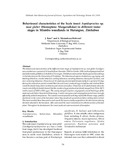Please use this identifier to cite or link to this item:
https://cris.library.msu.ac.zw//handle/11408/480| Title: | Behavioural characteristics of the scale insect aspidoproctus sp. near glaber (Homoptera: Margarodidae) in different instar stages in Miombo woodlands in Hurungwe, Zimbabwe | Authors: | Bare, J. Mutambara- Mabveni, A. |
Keywords: | Aspidoproctus | Issue Date: | 2012 | Publisher: | Midlands State University | Series/Report no.: | Midlands State University Journal of Science Agriculture and Technology;Vol. 3(1) | Abstract: | The behavioural characteristics of the different instar stages of Aspidoproctus sp. near glaber (Lindiger) were studied over a period of 10 months from December 1994 to October 1995 on Brachystegia boehimii and Julbernardia globiflora in the field in Hurungwe, Zimbabwe and on potted Afzelia quanzensis seedlings in the laboratory at the University of Zimbabwe. The behavioural aspects studied were egg-laying and hatching behaviour, crawler behaviour, settling behaviour, moulting behaviour, honey dew secretion, and over-wintering behaviour. Dissection of 20 randomly selected adult females daily for a period of 10 days during the oviposition period revealed that the scale insect produced eggs in batches and retained them inside the female body where incubation and eclosion took place. Dissection of 20 adult females when the insects were fully distended showed that the number of eggs produced per female ranged from 934 to 5673 (with a mean of 2403 ±1281 eggs). The newly emerged crawlers congregated around the fringes of the maternal scale before they started dispersing. Crawler emergence and congregation period were strongly affected by ambient temperature. The crawlers moved upwards until they reached the thinner twigs, petioles and leaves in the crown of the host plant where they wandered up and down before settling down to feed. The insect moulted three times and on each moult the insect actually escaped from the old exuvium leaving the latter attached to the host plant. After each moult the insect moved down to a thicker portion of the host plant. Throughout its development, the insect produced copious amounts of honeydew. | URI: | http://hdl.handle.net/11408/480 | ISSN: | 1992-0903 |
| Appears in Collections: | Research Papers |
Show full item record
Page view(s)
82
checked on Apr 19, 2025
Download(s)
10
checked on Apr 19, 2025
Google ScholarTM
Check
Items in MSUIR are protected by copyright, with all rights reserved, unless otherwise indicated.




